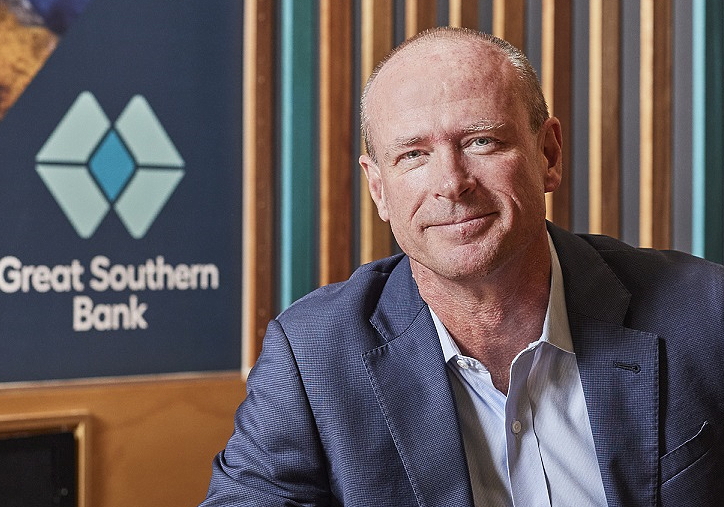
Great Southern Bank CEO Paul Lewis models the new look CUA
In a year of atypically low asset growth, a hefty investment spend and a monumental social crisis, Great Southern Bank has produced one of the bigger leaps in profit so far this season.
Great Southern Bank is the new name (since June) for CUA, Credit Union Australia — and the Brisbane-based bank’s somewhat grudging retirement of its traditional colours is one of many milestones with which the CUA, now a mutual bank, will long be associated.
Great Southern outlined its results for the year to June 2021 yesterday, headlined by a group net profit of A$49.1 million.
Growth on the balance sheet almost stalled, both sides, the selection of items disclosed by the bank yesterday and by APRA last week in their monthly banking statistics both show.
High-impact negotiation
masterclass
July 9 & 16, 2025
5:00pm - 8:30pm
This high-impact negotiation masterclass teaches practical strategies to help you succeed in challenging negotiations.
The bank’s “consolidated assets” were up 0.9 per cent over the year to $16.30 billion, the bank told members.
The more semantic APRA version shows a tiny decline in total assets for CUA over the full year, and a decline each month for eight months straight from July last year. And Great Southern have company — there's a handful of large-enough mutual banks bruised by the pandemic and with the stick stuck in reverse, especially on mortgages.
Retail customer deposits increased by 1.6 per cent to $11.3 billion, GSB said in its summary. APRA’s stats, though, shows a rise in household deposits of 4 per cent but a teeny dip on total deposits.
Even on the APRA numbers, GSB’s deposit growth last year was half the industry norm, or ‘system growth’ in deposits of 8.6 per cent. Amid the incredible excess of liquidity within the banking system, Great Southern Bank, as the largest mutual bank, will surely be able to harvest deposits in line with peers when it sets out.
Given balance sheet dynamics, the bank’s 9.6 per cent hike in total income to $328 million turns out to be down to, mainly, optimising their net interest margin (and a theme this bank reporting season).
The bank told Banking Day that the NIM “improved from 1.72 per cent in FY2020 to 1.86 per cent in FY2021”.
In line with the another trend this season, albeit in conservative CUA style, GSB released $2.4 million in pandemic-related provisions set aside last year. This is a second pillar of the profit jump.
This release represents one fifth of the $11.6 million set aside in FY2020 as “additional provisions for COVID-19 and natural disaster impacts on our loan book”.
The bank said that over FY2021, more than 99 per cent of the almost 5400 members dependent on loan deferrals in the middle of 2020 “have rolled off financial assistance, though volumes are still 30 per cent higher than pre-pandemic levels,” or they were at the end of June.
It is on the cost side – informed by critical and mostly successful investments in many things digital, compliance and risk – where Great Southern Bank is adding meat to its bones as long-term leader of the credit union and mutual bank pack.
Operating expenses soared, in deliberate fashion, by 11 per cent to $256 million.
Risk and compliance costs comprised the largest part of the increased spend, the bank explained to its members, “following heavy investment in Open Banking and uplifted capability in anti-money laundering [and] cyber resilience.
“Our investments this year focused on delivering customer needs,” Paul Lewis, CEO of Great Southern, told members yesterday.
“After gathering feedback from over 25,000 customers we have enabled improved digital customer interfaces and created clever savings features that allow customers to reach their financial goals faster,” he said.
These are all imperatives if GSB is to continue to match it in a world where VC and PE funding flows are enabling neobanks and fintechs.
In spite step down in assets over a long stretch of the year, key investments look to be supporting a turnaround.
“After a key technology rollout, home loan applications were up 31 per cent over the year, with momentum continuing into the new financial year.
“The technology upgrade and simplification of the operations business has resulted in a faster online home loan applications process for personal customers and brokers,” the bank said.
Active customer numbers rose to around 420,000 on the back of, according to the bank, “competitive offerings and ongoing infrastructure investment designed to improve and safeguard the customer experience”.
In a strategic simplification, the bank offloaded its health insurance business to HBF. CUA announced this sale in May, with completion scheduled by the end of September.
COVID (via a deferral of claims, mainly) aided the profit contributed by CUA Health. The NPAT for this division was up by more than half to $9.3 million. The bank then burned off half that profit in sale costs.
“We can achieve further significant cost benefits and efficiencies for our customers by increasing scale and efficiency,” Lewis assured his members yesterday.
“We take our responsibility as a customer owned bank seriously. We continue to provide community funding to help in three key areas – housing affordability, family violence and digital inclusion.”